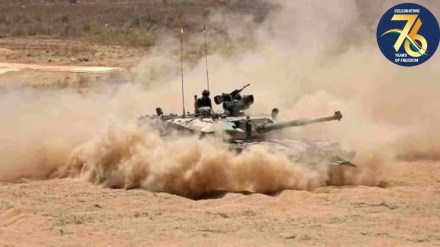Revamping its combat prowess, the Indian Army is set to overhaul its arsenal, bidding farewell to the aging Russian T-72 main battle tanks that have served for over four decades. The Army is embarking on a strategic transition to embrace cutting-edge Future Ready Combat Vehicles (FRCVs) by 2030.
This initiative entails the phased procurement of a formidable fleet of 1,770 FRCVs, ingeniously divided into three stages, each bolstering the Army’s capabilities. “The initial phase incorporates established technologies, in the second phase it will be integrating advanced innovations. As the grand finale, the third phase introduces futuristic breakthroughs that redefine the boundaries of warfare,” sources in the defence and security establishment said on the eve of 77th Independence Day Celebrations.
According to the sources quoted above, “The timeline is diligently structured, with an anticipated 4-5 years for development and an additional 1.5-2 years for full-scale production. Consequently, by 2030, the Army is poised to induct these cutting-edge marvels into its armored ranks, culminating in the final phase’s completion within the ensuing 10-12 years.”
Significance
This strategic evolution stems from a proactive consideration of the evolving threat landscape and the paramount need for maintaining combat superiority. “The reason to adapt emerged against the backdrop of a shifting combat paradigm and the imperative of securing a ‘combat overmatch’ against adversaries,” explained sources.
Financial Express Online has reported earlier, in June 2021, the Indian government issued a clarion call for 1,770 state-of-the-art, technology-enabled tanks, fortified to navigate diverse terrains and temperature extremities. The envisioned role for these FRCVs is nothing short of a stalwart, persisting as the cornerstone of the Army’s tank arsenal for the forthcoming 40-50 years.
The catalyst for this transformation lies in the relentless march of technology, ushering in novel threats from the aerial domain, encompassing UCAVs and Loitering Munitions. Enhanced Intelligence, Surveillance, and Reconnaissance (ISR) capabilities have engendered a more precise targeting landscape, compelling a unified and networked approach across all facets of military operations.
FRCV (Future Ready Combat Vehicle)
The FRCV is designed to replace the old T-72 Tank Fleet, which has been in service since 1979 and has reached the end of its useful life. Even if it’s introduced in 2027, it might still be used until 2040. Unfortunately, the MBT Arjun MK II 68 ton tank isn’t a suitable replacement due to its limitations in the Indian operational environment. “To ensure combat readiness and superiority over adversaries, it’s crucial to introduce the FRCV as soon as possible, with a clear plan for its implementation. This vehicle can also serve as a foundation for developing a range of combat vehicles with a standardized platform, contributing to technological advancement and local manufacturing,” explained an expert.
The history of FRCV’s development
Originally planned as part of the Make Project since 2008-09, the slow progress of other projects led to a shift in approach. It was proposed as a standalone project outside the DPP (Defence Procurement Procedure) under MoD (Ministry of Defence). This involved selecting a design through competition, shortlisting a developer, and then production through a nominated agency. A request for information (RFI) was issued in June 2015 to invite design proposals, which received good responses. However, changes in leadership led to shifting FRCV back under the MAKE 1 project with the updated DPP in 2016. Subsequently, it was considered under the Strategic Partnership (SP) model, posing challenges and uncertainties.
Under this model, a foreign Original Equipment Manufacturer (OEM) partners with an Indian company selected by MoD. After RFIs from foreign partners and the selection of an Indian partner, the project moves forward. The project’s success hinges on the efficient approval of PSQR (Project Specific Qualitative Requirements) by service headquarters and AoN (Acceptance of Necessity) by MoD. Establishing a solid relationship with the foreign partner based on technology vectors is crucial for progress.
The fast-paced technology landscape and unpredictable operational environment require quick decision-making for defence procurement and capability development. Developing FRCV is challenging and operationally crucial, demanding a responsive and time-sensitive environment. Success in these projects could lead to self-reliance and advanced technology integration, invigorating the Indian Defence ecosystem.
In embracing these innovative FRCVs, the Indian Army’s commitment to staying ahead of the curve remains unwavering, symbolizing its preparedness to tackle the dynamic challenges of the modern battlefield.
